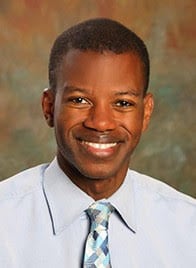Frank Clark, MD, still remembers the person who told him that he was not cut out for medicine.
“She encouraged me to pursue a different career. It’s possible that there were some racial undertones to what she was telling me,” Dr. Clark, an African-American practicing psychiatrist, told AMA Wire®. “I remember going home and telling my mother what this woman had said and hearing my mother use some choice words, which I will not repeat. But I also remember my mother saying, ‘Don’t let people tell you what you can and can’t do.’”
It is that kind of story of determination against the odds, of facing failure and rebounding to achieve his dream of being a physician, that Dr. Clark brings with him each time he participates in the AMA’s Doctors Back to School™ Program. The program sends physicians of color from communities underrepresented in the medical profession to schools with high-minority populations.
As a psychiatrist and vice chair of the psychiatry department at Carilion Clinic St. Albans Hospital in Christiansburg, Virginia, an assistant professor at the Virginia Tech Carilion School of Medicine and Research Institute, and the Young Physicians Section representative and chair of the AMA’s Minority Affairs Section Governing Council, Dr. Clark is not wanting for professional responsibilities. But no matter how busy he may be, he always makes time to speak to elementary, middle and high school students as a participant in the AMA program.
“It is one of my favorite things to do,” said Dr. Clark, 35. “As physicians, we are called to go above and beyond the bedside and into our communities.”
The goal of the program’s Doctors Back to School Day, which this year is May 3, is to whet underrepresented minority students’ interest in health care careers, including medicine, and to show them that their professional dreams are attainable.
While Americans of African, Latino, Native American, Alaskan or Hawaiian descent make up about a quarter of the U.S. population, these groups together account for less than 9 percent of the country’s physician workforce. The hope is that boosting the share of underrepresented minorities in medicine could help reduce health disparities among these patient populations.
An important goal for Dr. Clark—who regularly talks to students of color, not just on Doctors Back to School Day—is to provide students with what he refers to as “racial concordance”: the comfort of seeing someone who looks like them in a profession to which they may aspire. From the students’ perspective, “it is important to meet people you can emulate and think, ‘I am able to do what they’re doing,’” Dr. Clark said.
The most powerful way to get through to students is by “talking about your journey,” said Dr. Clark. “It’s about giving your testimony, being honest and transparent. When children hear your stories, they have a curiosity. We want to let them know that if we did it, they can do it, too.”
Dr. Clark’s story started on Chicago’s far South Side, where he grew up with his public school teacher mother and preacher father, and extended to Northwestern University’s Feinberg School of Medicine and an internship and residencies at the University of South Carolina School of Medicine. Along the way, he benefited from the examples of a number of African-American mentors who took him under their wings.
“It was helpful to have people who looked like me,” he said.
In his school visits, Dr. Clark also emphasizes a message of resilience. He shares with students his profound disappointment in failing both his first year of medical school and Step 1 of his medical school boards. “It was a humbling experience, but I am a better human being and physician because of it,” he said. “It is easy to become discouraged, but you should not lose hope. Remember to focus your eyes on the end goal.”
A six-year veteran of the Doctors Back to School Program, Dr. Clark said it is more important than ever before, given the falling numbers of black men pursuing medicine as a career.
By talking to students as young as elementary-school age, Dr. Clark seeks to change the narrative about black men in this country. “When you see a black man in the news, it is usually not for something good,” he said.
Investments of time, caring and mentorship can make the difference, Dr. Clark said. “That’s how you get more black males in medicine,” he said.
Learn how to participate in Doctors Back to School Day. While it is officially marked on May 3 this year, physicians can go “back to school” any day of the year. Download this toolkit for step-by-step guidance. If you do participate this year, you can let your friends and colleagues know about it by using the #DrsBacktoSchool Day tag on social media.




